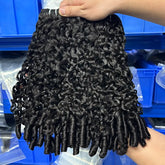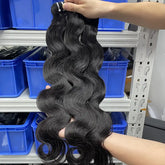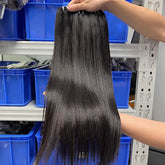Shedding, Tangling, and Tones: A Small Business Guide to Identifying and Solving Common Hair Quality Issues

Running a hair business means dealing with quality issues that can make or break client relationships. Whether you're a salon owner, stylist, or hair boutique operator, understanding how to identify and resolve common hair problems is essential for maintaining your reputation and keeping customers happy.
Let's dive into the most frequent hair quality challenges and practical solutions that actually work in real-world scenarios.
The Big Three: Most Common Hair Quality Issues
| Issue Type | What to Look For | Root Causes | Impact on Business |
|---|---|---|---|
| Excessive Shedding |
|
|
|
| Matting & Tangling |
|
|
|
| Color Inconsistencies |
|
|
|
Your Quality Control Checklist
Before accepting any shipment from suppliers, implement this inspection routine:
Physical Inspection (Every Bundle):
- Run fingers through hair from root to tip—it should feel smooth in one direction
- Check weft construction for loose threads or gaps
- Examine color consistency in natural light
- Test a small section with water to check for immediate tangling
The 24-Hour Test:
- Wet a small section and let it air dry
- Brush gently and note shedding amount
- Check for texture changes or increased tangling
Documentation:
- Photo any inconsistencies
- Record lot numbers and supplier batch information
- Note client feedback patterns for future reference
Practical Problem-Solving Strategies
| Problem | Immediate Solutions | Long-term Fixes | Prevention Tips |
|---|---|---|---|
| Excessive Shedding |
|
|
|
| Tangling Issues |
|
|
|
| Color Problems |
|
|
|
Real-World Supplier Scenarios
Case Study 1: The Disappearing Supplier
A salon owner I worked with built their entire inventory around one overseas supplier offering "premium" hair at budget prices. Three months in, the supplier disappeared after delivering increasingly poor quality hair. The lesson? Always maintain relationships with at least two reliable suppliers, even if it means higher costs initially.
Case Study 2: The Batch Variation Nightmare
A boutique ordered 50 bundles of "Brazilian Body Wave" for a large wedding party. When the hair arrived, it contained three distinctly different curl patterns and textures. The supplier's response? "Natural hair varies." This taught the owner to specify exact curl definitions and request all hair come from the same processing date.
Case Study 3: The Chemical Processing Cover-Up
One supplier's "virgin" hair started melting when exposed to heat styling. Investigation revealed heavy chemical processing that wasn't disclosed. The salon learned to always perform strand tests with heat tools before accepting large shipments.
Building Your Hair Quality Standards
| Area | Requirements | Implementation | Success Metrics |
|---|---|---|---|
| Supplier Management |
|
|
|
| Client Communication |
|
|
|
| Staff Training |
|
|
|
When to Cut Your Losses: Decision Matrix
| Situation | Red Flags | Action Required | Timeline |
|---|---|---|---|
| Minor Issues |
|
|
2-4 weeks |
| Moderate Problems |
|
|
4-8 weeks |
| Major Quality Failures |
|
|
Immediate |
Cost-Benefit Analysis Questions:
- Are fixing costs exceeding replacement costs?
- Is this affecting repeat business?
- Can your reputation recover from continued issues?
Moving Forward
Quality hair is an investment, not an expense. While cheaper options might seem attractive, the cost of handling returns, upset clients, and damaged reputation often exceeds the initial savings.
Focus on building relationships with suppliers who understand your quality standards and stand behind their products. Document everything, communicate clearly with clients, and never compromise on the standards that built your business.
Remember, every quality issue you solve effectively becomes a learning opportunity that makes your business stronger and more reliable in the long run.







